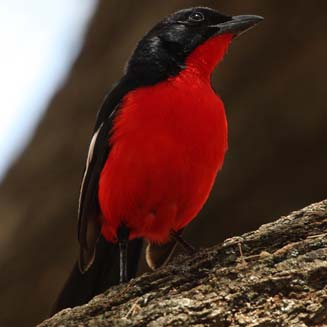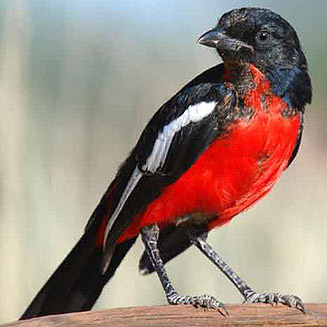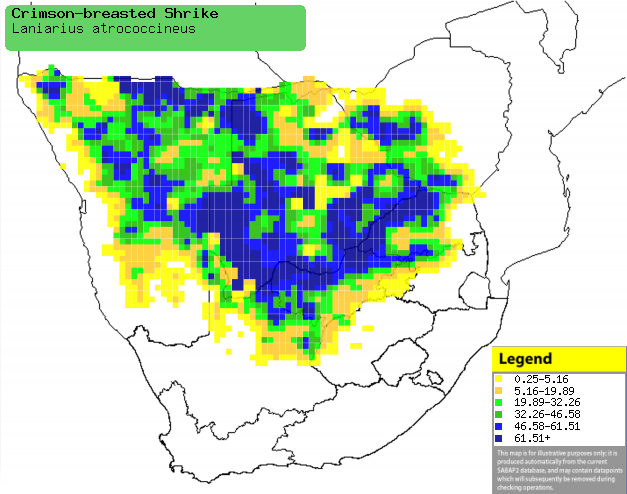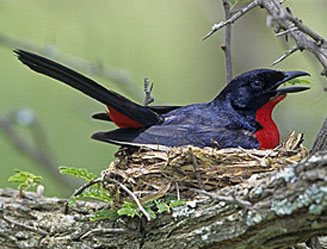|
Laniarius atrococcineus
(Crimson-breasted shrike, Crimson-breasted boubou)
Rooiborslaksman [Afrikaans]; Etwakura [Kwangali];
Kgaragoba, Kgorogoro [Tswana]; Burchell-fiskaal [Dutch]; Gonolek rouge et noir
[French]; Rotbauchwürger, Reichsvogel, Kaiservogel [German];
Picanço-preto-e-vermelho [Portuguese]
Life > Eukaryotes > Opisthokonta > Metazoa (animals) > Bilateria > Deuterostomia > Chordata > Craniata > Vertebrata (vertebrates) > Gnathostomata (jawed vertebrates) > Teleostomi (teleost fish) > Osteichthyes (bony fish) > Class: Sarcopterygii (lobe-finned fish) > Stegocephalia (terrestrial vertebrates) > Tetrapoda (four-legged vertebrates) > Reptiliomorpha > Amniota > Reptilia (reptiles) > Romeriida > Diapsida > Archosauromorpha > Archosauria > Dinosauria (dinosaurs) > Saurischia > Theropoda (bipedal predatory dinosaurs) > Coelurosauria > Maniraptora > Aves (birds) > Order: Passeriformes > Family: Malaconotidae
 |
 |
|
Crimson-breasted shrike, Mokala National Park,
South Africa. [photo
Duncan Robertson ©]. |
Crimson-breasted shrike juvenile. [photo Callie de Wet ©] |
Distribution and habitat
Occurs in a band from Angola and Zambia to northern areas
of South Africa, with large populations in Namibia, Botswana and western
Zimbabwe. It generally prefers arid habitats, especially Kalahari thornveld,
Acacia savanna and semi-arid scrub, largely absent from desert.
|
 |
|
Distribution of Crimson-breasted shrike in southern Africa,
based on statistical smoothing of the records from first SA Bird Atlas
Project (©
Animal Demography unit, University of
Cape Town; smoothing by Birgit Erni and Francesca Little). Colours range
from dark blue (most common) through to yellow (least common).
See here for the latest distribution
from the SABAP2. |
Food
It mainly eats insects, gleaning prey from the leaves and
trunks of trees, often flying to the ground to feed on ants or some fallen
fruit. The following food items have been recorded in its diet:
Breeding
- Both sexes construct the nest, which is a tidy cup made almost entirely of
Acacia tree bark, collected from trunks and branches about 50-90
metres from the nesting site and lined with grass and rootlets. It is
usually bound with spider web to a fork in the main stem of a plant, or
occasionally onto a horizontal branch. Most of the construction work is done
in the early morning, and it is usually complete after about 4-6 days.
 |
|
|
Crimson-breasted shrike in its nest, Nylsvley area
, South Africa. [photo Warwick Tarboton ©] |
|
- Egg-laying season is from August-january, peaking from October-November.
- It lays 2-3 eggs, which are incubated by both sexes for about 15-17
days.
- The chicks are fed and brooded by both parents, leaving the est at about
18-20 days old. Although they forage independently, they stil come back to
roost with their parents, sometimes only leaving in next years breeding
season.
Threats
Not threatened.
References
-
Hockey PAR, Dean WRJ and Ryan PG 2005. Roberts
- Birds of southern Africa, VIIth ed. The Trustees of the John Voelcker
Bird Book Fund, Cape Town.
|
